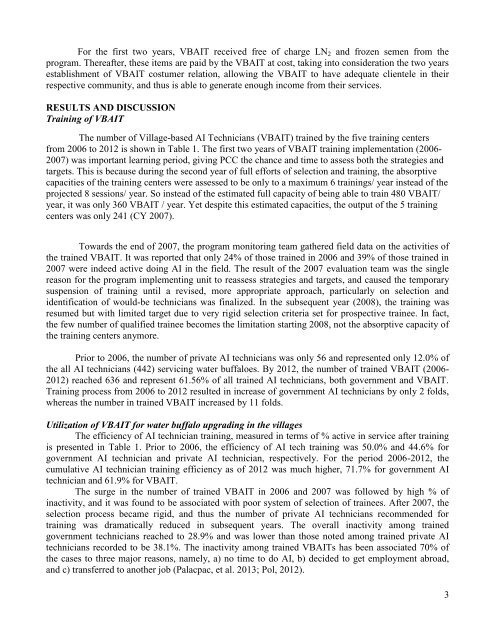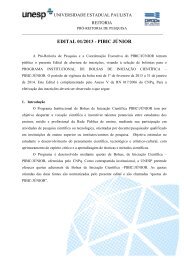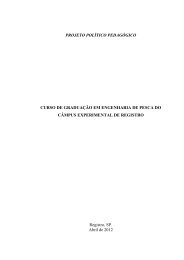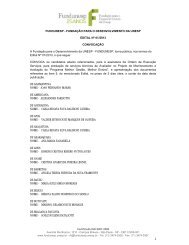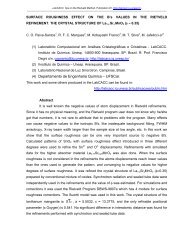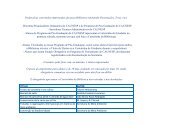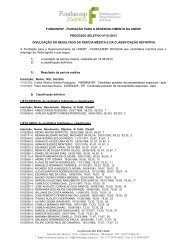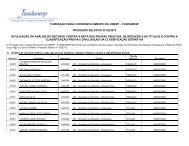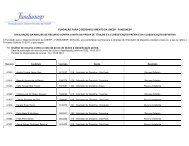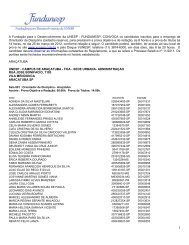Untitled - Faculdade de Medicina Veterinária e Zootecnia - Unesp
Untitled - Faculdade de Medicina Veterinária e Zootecnia - Unesp
Untitled - Faculdade de Medicina Veterinária e Zootecnia - Unesp
Create successful ePaper yourself
Turn your PDF publications into a flip-book with our unique Google optimized e-Paper software.
For the first two years, VBAIT received free of charge LN 2 and frozen semen from the<br />
program. Thereafter, these items are paid by the VBAIT at cost, taking into consi<strong>de</strong>ration the two years<br />
establishment of VBAIT costumer relation, allowing the VBAIT to have a<strong>de</strong>quate clientele in their<br />
respective community, and thus is able to generate enough income from their services.<br />
RESULTS AND DISCUSSION<br />
Training of VBAIT<br />
The number of Village-based AI Technicians (VBAIT) trained by the five training centers<br />
from 2006 to 2012 is shown in Table 1. The first two years of VBAIT training implementation (2006-<br />
2007) was important learning period, giving PCC the chance and time to assess both the strategies and<br />
targets. This is because during the second year of full efforts of selection and training, the absorptive<br />
capacities of the training centers were assessed to be only to a maximum 6 trainings/ year instead of the<br />
projected 8 sessions/ year. So instead of the estimated full capacity of being able to train 480 VBAIT/<br />
year, it was only 360 VBAIT / year. Yet <strong>de</strong>spite this estimated capacities, the output of the 5 training<br />
centers was only 241 (CY 2007).<br />
Towards the end of 2007, the program monitoring team gathered field data on the activities of<br />
the trained VBAIT. It was reported that only 24% of those trained in 2006 and 39% of those trained in<br />
2007 were in<strong>de</strong>ed active doing AI in the field. The result of the 2007 evaluation team was the single<br />
reason for the program implementing unit to reassess strategies and targets, and caused the temporary<br />
suspension of training until a revised, more appropriate approach, particularly on selection and<br />
i<strong>de</strong>ntification of would-be technicians was finalized. In the subsequent year (2008), the training was<br />
resumed but with limited target due to very rigid selection criteria set for prospective trainee. In fact,<br />
the few number of qualified trainee becomes the limitation starting 2008, not the absorptive capacity of<br />
the training centers anymore.<br />
Prior to 2006, the number of private AI technicians was only 56 and represented only 12.0% of<br />
the all AI technicians (442) servicing water buffaloes. By 2012, the number of trained VBAIT (2006-<br />
2012) reached 636 and represent 61.56% of all trained AI technicians, both government and VBAIT.<br />
Training process from 2006 to 2012 resulted in increase of government AI technicians by only 2 folds,<br />
whereas the number in trained VBAIT increased by 11 folds.<br />
Utilization of VBAIT for water buffalo upgrading in the villages<br />
The efficiency of AI technician training, measured in terms of % active in service after training<br />
is presented in Table 1. Prior to 2006, the efficiency of AI tech training was 50.0% and 44.6% for<br />
government AI technician and private AI technician, respectively. For the period 2006-2012, the<br />
cumulative AI technician training efficiency as of 2012 was much higher, 71.7% for government AI<br />
technician and 61.9% for VBAIT.<br />
The surge in the number of trained VBAIT in 2006 and 2007 was followed by high % of<br />
inactivity, and it was found to be associated with poor system of selection of trainees. After 2007, the<br />
selection process became rigid, and thus the number of private AI technicians recommen<strong>de</strong>d for<br />
training was dramatically reduced in subsequent years. The overall inactivity among trained<br />
government technicians reached to 28.9% and was lower than those noted among trained private AI<br />
technicians recor<strong>de</strong>d to be 38.1%. The inactivity among trained VBAITs has been associated 70% of<br />
the cases to three major reasons, namely, a) no time to do AI, b) <strong>de</strong>ci<strong>de</strong>d to get employment abroad,<br />
and c) transferred to another job (Palacpac, et al. 2013; Pol, 2012).<br />
3


